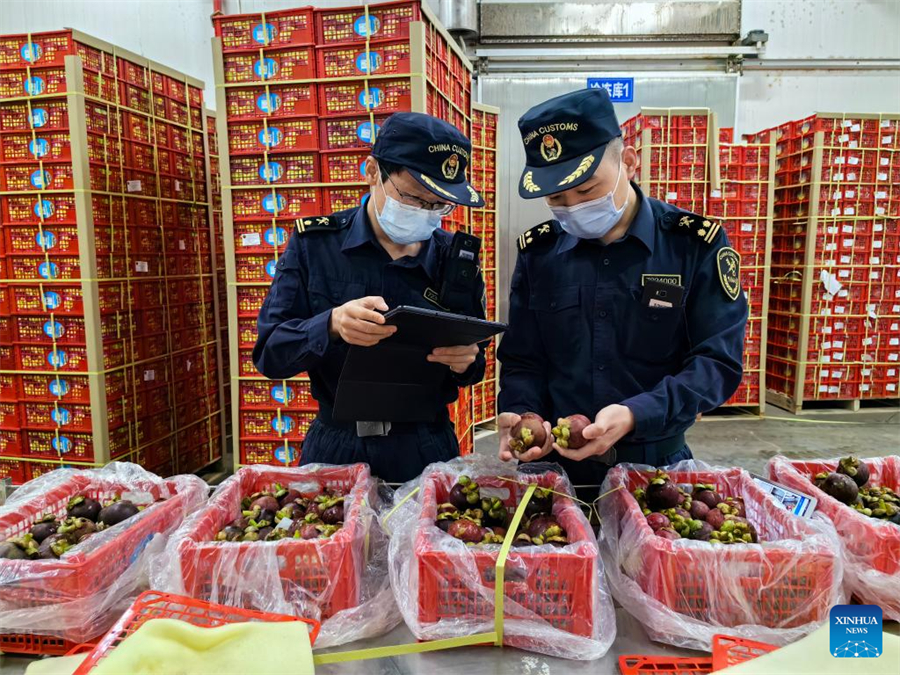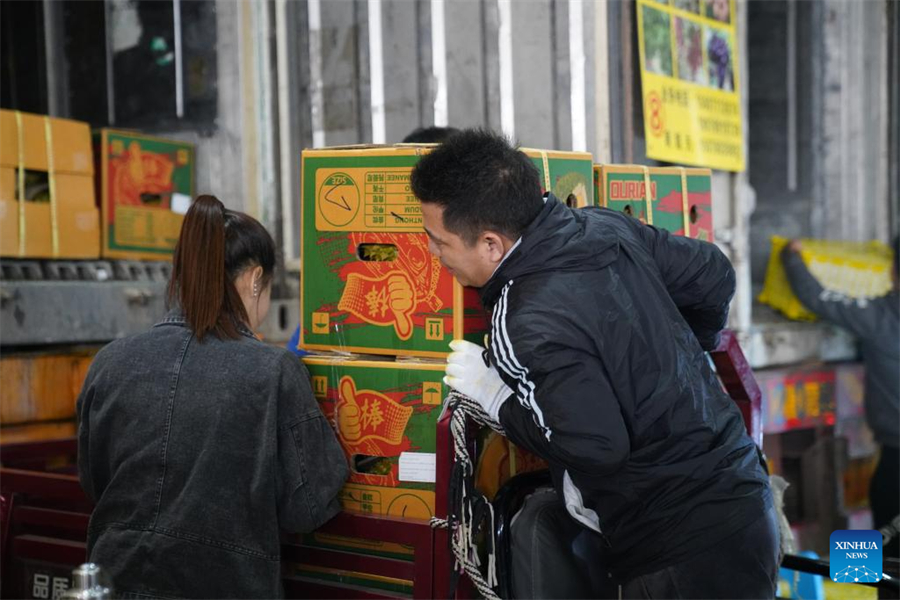Land-sea corridor facilitates fruit trade between China, ASEAN

Officers of Qinzhou Port Customs check imported mangosteens at the Qinzhou Port in Qinzhou City, south China's Guangxi Zhuang Autonomous Region, March 25, 2024. [Photo by Li Fuyang/Xinhua]
NANNING -- After an eight-day voyage, a cargo ship loaded with 68 tonnes of mangosteens docked at the port of Qinzhou in south China's Guangxi Zhuang Autonomous Region. Having cleared customs swiftly, the fruits imported from Indonesia were transported to nearby provinces, as well as the Guangdong-Hong Kong-Macao Greater Bay Area and the Yangtze River Delta.
As a pivotal hub along the New International Land-Sea Trade Corridor, the port of Qinzhou witnesses a daily hustle and bustle of rail-sea intermodal trains delivering cargo from the Association of Southeast Asian Nations (ASEAN) countries to China's inland regions.
Launched in 2017, the New International Land-Sea Trade Corridor is a trade and logistics passage jointly built by provincial-level regions in western China and ASEAN members. Today, thanks to the corridor, more and more fruits from Southeast Asia can reach the Chinese market and meet the growing and diversified needs of Chinese consumers.
"In the past, our imported fruits were disembarked at Nansha District of Guangzhou," said Huang Liangsong, a staff member of Guangxi Zhengfan International Logistics Co., Ltd., adding that nowadays the import logistics of the port of Qinzhou are faster and more cost-effective thanks to the continuous expansion of foreign trade routes. "With the arrival of the fruit season, an assortment of ASEAN fruits will be shipped to the port this year," he said.
To further spur the flow of agricultural products from ASEAN countries to the Chinese market, the port of Qinzhou has established several tropical fruit express lines as well as optimized cold chain, cold storage, and other supporting infrastructure.
"We launched an express line from Laem Chabang of Thailand to Qinzhou which runs four times a week, and the fruits can reach China within three days," said Zuo Kongtian, an official with the Qinzhou Port area of the Guangxi Free Trade Zone.
According to customs statistics, from January to February this year, fruit imports through Qinzhou Port -- mostly longan, coconut, mango and mangosteen -- totaled more than 3,300 tonnes, with a total value of 25.43 million yuan (about 3.51 million U.S. dollars), up 178.4 percent and 292.5 percent year on year, respectively.
In addition, the establishment of a fruit trade center in collaboration with ASEAN countries in Qinzhou has also contributed to the efficiency customs clearance. "We have set up an inbound fruit 'green channel' to largely reduce the waiting time and to ensure streamlined customs clearance processes," said Cao Teng, an officer at Qinzhou Port Customs.
Youyi Pass, over 200 kilometers from Qinzhou Port, is nestled on the China-Vietnam border in Guangxi. It saw 23.88 billion yuan worth of fruits imported in 2023, reflecting a 262.3 percent year-on-year increase, according to local customs statistics.
Early April marks the first peak of the massive influx of tropical fruits via Youyi Pass, China's major land route to Vietnam and Southeast Asia, where trucks loaded with ripe durians and jackfruit form queues for customs clearance at this time of year.
According to Wang Zhengbo, president of a Guangxi-based supply chain management company, business collaboration opportunities between China and ASEAN have continued to grow in recent years, boosting the demand for and the quantity and variety of goods in cross-border trade, as well as seeing continuous increases in freight volume.
The New International Land-Sea Trade Corridor is also an economic corridor featuring in-depth integration of transportation, logistics, commerce and industry, thereby creating significant opportunities for industrial cooperation among countries.
"With the effective implementation of the Regional Comprehensive Economic Partnership and the acceleration of the construction of the land-sea trade corridor, economic and trade cooperation between China and the ASEAN will bring about new opportunities," said Zuo.

Vendors transport packaged durians at Haijixing Market, a large wholesale fruit market, in Nanning, south China's Guangxi Zhuang Autonomous Region, April 25, 2023. [Xinhua/Zhao Huan]
























